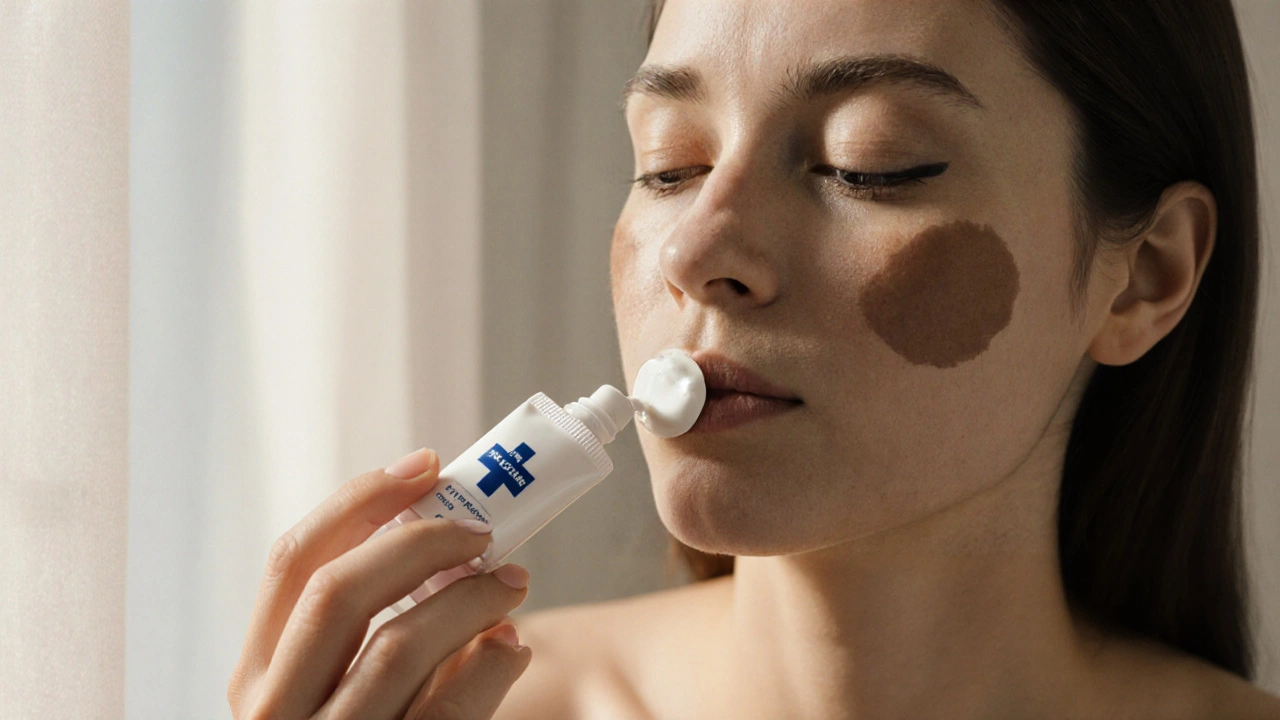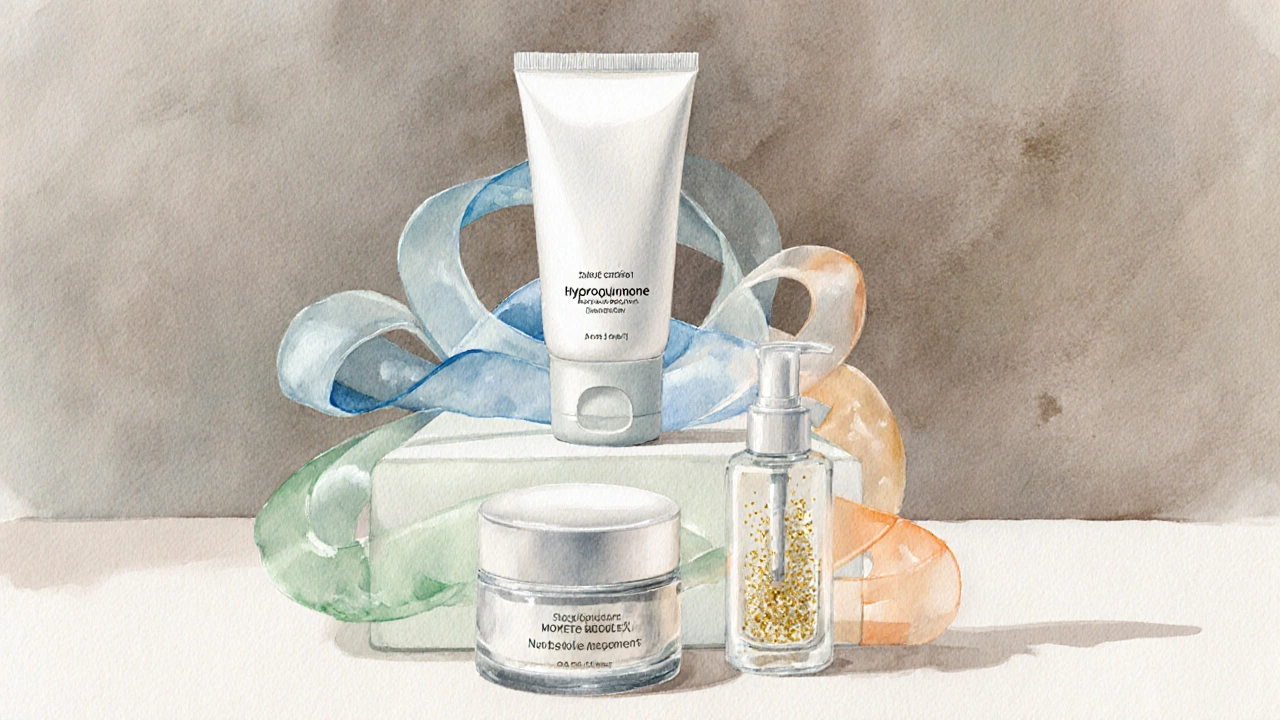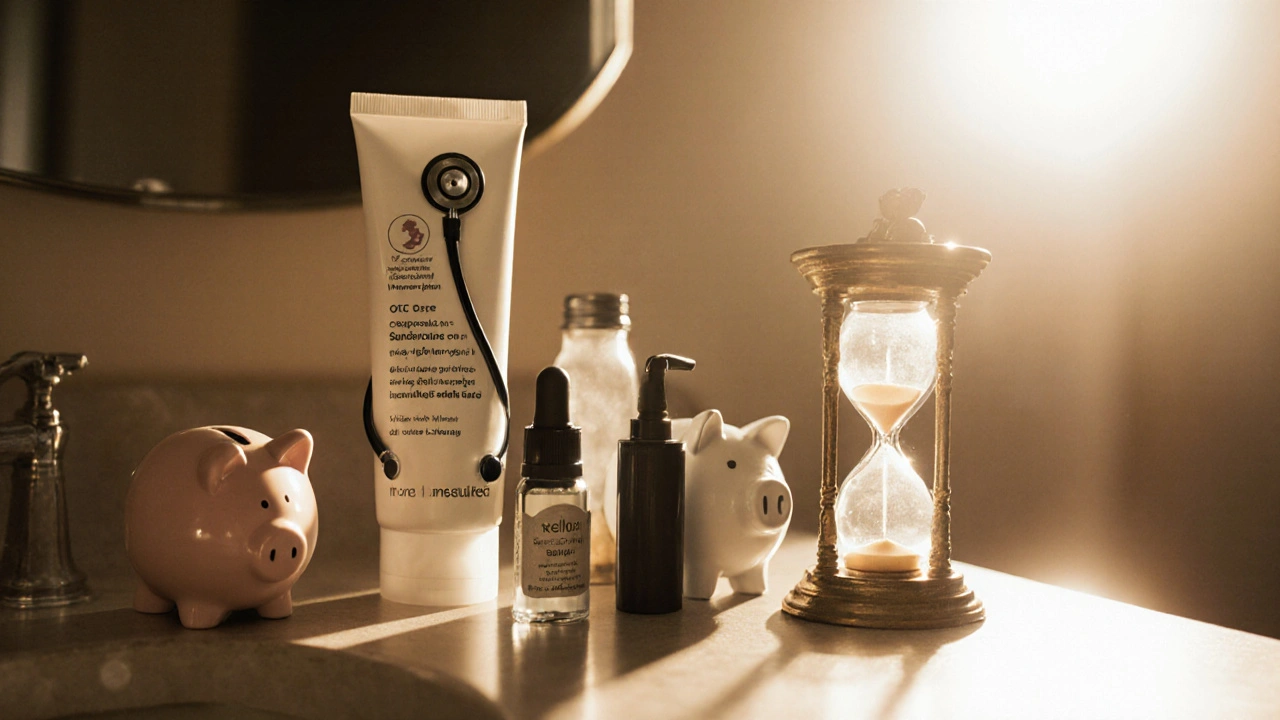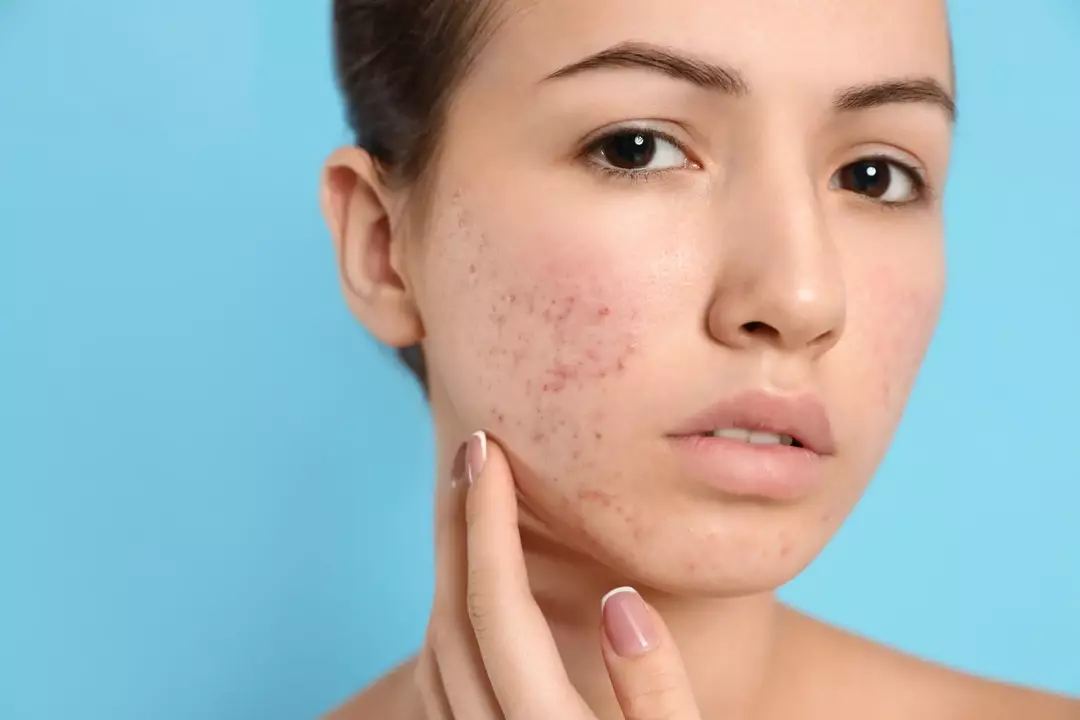
Key Takeaways
- Melacare Forte Cream combines hydroquinone, mometasone and tretinoin for aggressive melasma management.
- Prescription status means close doctor supervision is needed.
- Safer over‑the‑counter options exist, but they work slower and may need longer treatment windows.
- Side‑effects like irritation, redness and rare steroid‑induced acne are the main trade‑off.
- A clear decision matrix (severity, budget, tolerance) helps pick the right product.
What is Melacare Forte Cream?
Melacare Forte Cream is a prescription blend of three active ingredients designed to target stubborn hyperpigmentation. The formulation includes hydroquinone (a melanin synthesis inhibitor), mometasone (a low‑potency topical corticosteroid) and tretinoin (a retinoid that speeds cell turnover). Marketed in many countries under the name Melacare Forte, the cream is typically prescribed for melasma, post‑inflammatory hyperpigmentation and other dyspigmentation disorders.
How It Works
The three components act synergistically:
- Hydroquinone blocks the enzyme tyrosinase, curbing melanin production at the source.
- Mometasone reduces inflammation that can otherwise stimulate melanocytes, calming the skin while the bleaching action occurs.
- Tretinoin accelerates epidermal turnover, helping to shed pigmented cells faster and enhancing the penetration of hydroquinone.
Because each ingredient addresses a different stage of the pigmentation cycle, the combo can produce noticeable lightening within 4‑6 weeks when used as directed.
Safety Profile and Common Side‑Effects
Being a prescription product, Melacare Forte carries a higher risk profile than simple OTC brightening creams. Typical concerns include:
- Transient erythema, burning or stinging during the first few days.
- Possible steroid‑induced acne or folliculitis if used longer than 8 weeks.
- Rare but reported cases of exogenous ochronosis (a paradoxical darkening) with prolonged hydroquinone use.
- Increased photosensitivity - rigorous sunscreen use (SPF30+ broad‑spectrum) is mandatory.
Doctors usually limit treatment cycles to 12 weeks, followed by a maintenance phase with a milder agent or intermittent use.

Top Alternatives to Consider
If you prefer a non‑prescription route or have a lower tolerance for steroids, several alternatives perform similarly for mild‑to‑moderate hyperpigmentation.
- Tri‑Luma Cream - combines 4% hydroquinone, 0.05% tretinoin and 0.1% fluocinolone acetonide. It’s a step‑down formula often used after a Melacare cycle.
- Azelaic Acid Cream (15‑20%) - a gentler depigmenting agent that also combats acne, suitable for sensitive skin.
- Kojic Acid Serum (5‑10%) - a natural fermentation product that inhibits tyrosinase without steroids.
- Niacinamide Lotion (4%) - a vitamin B3 derivative that reduces melanin transfer and improves barrier function.
Side‑by‑Side Comparison
| Attribute | Melacare Forte | Tri‑Luma Cream | Azelaic Acid Cream | Kojic Acid Serum | Niacinamide Lotion |
|---|---|---|---|---|---|
| Key Actives | Hydroquinone4%, Mometasone0.1%, Tretinoin0.05% | Hydroquinone4%, Tretinoin0.05%, Fluocinolone0.1% | Azelaic Acid15‑20% | Kojic Acid5‑10% | Niacinamide4% |
| Prescription? | Yes | Yes (often requires doctor approval) | No (OTC in many markets) | No (OTC) | No (OTC) |
| Typical Treatment Length | 8‑12 weeks (follow‑up) | 8‑12 weeks | 12‑24 weeks | 12‑20 weeks | Indefinite, low‑risk |
| Major Side‑Effects | Steroid acne, irritation, rare ochronosis | Similar steroid‑related risks | Mild tingling, dryness | Possible contact dermatitis | Very low; occasional flushing |
| Cost (US$ per month) | ~$120‑$150 (prescription) | ~$100‑$130 | ~$30‑$45 | ~$25‑$40 | ~$20‑$35 |
| Best For | Severe melasma, rapid results needed | Post‑Melacare maintenance | Mild‑moderate hyperpigmentation, acne‑prone skin | Sensitive skin, natural‑product seekers | Daily brightening, barrier repair |
How to Choose the Right Product
Consider these decision points before committing:
- Severity of discoloration - Deep melasma often needs the triple‑action of Melacare; lighter patches respond to gentler agents.
- Doctor involvement - If you have easy access to a dermatologist, prescription creams are viable; otherwise, OTC options reduce the need for visits.
- Skin tolerance - History of steroid reactions or retinoid irritation pushes the choice toward azelaic acid or niacinamide.
- Budget constraints - Prescription regimens can exceed $150/month, while OTC alternatives stay under $50.
- Timeframe expectations - Expect 4‑6 weeks for noticeable change with Melacare; OTC products may need 3‑6 months.
Map your answers onto the table above; the column that aligns with most of your criteria is the logical pick.

Best‑For / Not‑For Snapshot
- Melacare Forte Cream: Best for aggressive melasma, professional supervision, and patients who can commit to strict sunscreen use. Not for pregnant women, steroid‑sensitive individuals, or those with a limited budget.
- Tri‑Luma Cream: Ideal as a step‑down after Melacare, or for patients who need a slightly milder steroid. Avoid if you’ve had steroid acne.
- Azelaic Acid Cream: Great for combined acne‑hyperpigmentation and for skin that can’t tolerate steroids. Not as fast‑acting for deep melasma.
- Kojic Acid Serum: Suitable for sensitive skins seeking natural ingredients. Risk of allergic reactions; use patch test.
- Niacinamide Lotion: Perfect for daily maintenance and all skin types. Won’t dramatically erase severe melasma but prevents new spots.
Practical Tips for Safe Use
- Always perform a 48‑hour patch test on the inner forearm before applying to the face.
- Apply a pea‑sized amount in the evening; avoid eyes, lips, and broken skin.
- Follow with a broad‑spectrum sunscreen (SPF30‑50) every morning, reapplying every 2hours outdoors.
- Do not combine multiple bleaching agents (e.g., hydroquinone + kojic acid) without professional guidance.
- Schedule a follow‑up with your dermatologist after 8 weeks to assess response and decide on continuation.
Frequently Asked Questions
Can I use Melacare Forte Cream if I’m pregnant?
No. Hydroquinone and tretinoin are classified as pregnancy‑category C and should be avoided because they may affect fetal development. Consult your OB‑GYN for safer alternatives.
How long should I wait before switching from Melacare to an OTC product?
Most dermatologists recommend a taper period of 2‑4 weeks after stopping the prescription, then transition to a milder agent like azelaic acid or niacinamide.
Is the steroid in Melacare Forte Cream safe for long‑term use?
Mometasone is a low‑potency steroid, but prolonged exposure can thin the skin and cause acne. Limit the full‑strength regimen to 12 weeks and follow a maintenance plan.
What is exogenous ochronosis and how can I avoid it?
It is a paradoxical darkening that can appear after years of high‑dose hydroquinone use. To avoid it, stick to the prescribed concentration (≤4%), limit treatment cycles, and incorporate a non‑hydroquinone maintenance product.
Can I combine sunscreen with melasma‑targeted serums?
Absolutely. In fact, layering a vitaminC serum or niacinamide lotion under sunscreen boosts brightening while protecting against UV‑induced re‑pigmentation.






Crystal Heim
October 5, 2025 AT 13:35Melacare is overhyped stick to cheaper OTC options.
Sruthi V Nair
October 6, 2025 AT 06:15The journey to even skin is a marathon not a sprint and the right product depends on how your body reacts to active ingredients. Melacare promises fast results but it also demands strict sunscreen discipline which many skip. Consider starting with a gentler azelaic routine to build tolerance before jumping into prescription strength. Consistency and patience will outshine any quick fix. Remember your skin health is a lifelong commitment.
Mustapha Mustapha
October 6, 2025 AT 22:55Sounds like you’ve done your homework the combo does tackle melasma from three angles and that synergy can shave weeks off the timeline. Just keep an eye on any steroid acne and pull back if irritation spikes. Having a dermatologist monitor the cycle is smart. Overall it’s a solid choice for stubborn spots when you can afford the cost.
Ben Muncie
October 7, 2025 AT 15:35Using a steroid without supervision feels irresponsible and undermines true skin wellness.
kevin tarp
October 8, 2025 AT 08:15Just a heads‑up the term “hydroquinone” should be capitalised only if it starts a sentence; otherwise keep it lowercase. Also “low‑potency” needs a hyphen. Minor details but they matter for clarity.
ravi kumar
October 9, 2025 AT 00:55Our Indian market offers plenty of homegrown brightening serums that rival foreign brands, and we don’t have to rely on expensive imported prescriptions. Many of the local labs produce azelaic creams at a fraction of the cost while adhering to strict GMP standards. It’s a shame some reviewers ignore these alternatives in favor of Western hype. Choose wisely and support domestic innovation.
SandraAnn Clark
October 9, 2025 AT 17:35These creams sound fancy but I bet they’re just pricey vibes.
Rex Wang
October 10, 2025 AT 10:15Wow, what an exhaustive breakdown, truly impressive, really helpful, thanks for the effort!
mark Lapardin
October 11, 2025 AT 02:55From a formulation perspective, the triple‑action of hydroquinone, mometasone, and tretinoin creates a synergistic depigmentation cascade that modulates melanogenesis, inflammation, and keratinocyte turnover concurrently, which is why the clinical outcomes are accelerated relative to monotherapy protocols.
Barry Singleton
October 11, 2025 AT 19:35The risk‑benefit matrix tilts unfavorably when you factor in the iatrogenic potential for steroid‑induced dysbiosis and the documented cases of exogenous ochronosis, rendering Melacare a high‑maintenance candidate best reserved for refractory melasma under strict supervision.
Javier Garcia
October 12, 2025 AT 12:15OTC options may be slower but they avoid the systemic concerns tied to prescription steroids.
christian quituisaca
October 13, 2025 AT 04:55Choosing the right brightening regimen feels like picking a paintbrush for a masterpiece.
Your skin is a living canvas and each active ingredient adds a different stroke of texture and tone.
Melacare’s triple‑action formula is like a spark‑plug that jump‑starts the depigmentation engine.
Hydroquinone tackles melanin synthesis at its source, while mometasone soothes the inflammatory backdrop.
Tretinoin then sweeps away the old, making room for fresh, evenly pigmented cells.
The result can be dramatic, but the road to that glow often passes through periods of redness and tightness.
In my experience, consistent SPF 50+ application acts as the protective umbrella that keeps the progress from eroding under UV assault.
For those on a tighter budget, azelaic acid offers a gentler yet effective alternative that doubles as an acne‑fighter.
Kojic acid, on the other hand, brings a natural fermentation vibe but can irritate sensitive skin if over‑applied.
Niacinamide, the unsung hero, subtly shifts melanin transfer and reinforces barrier function without the drama.
When you map your skin’s tolerance, financial comfort, and timeline expectations onto the comparison table, the picture becomes crystal clear.
I’ve seen patients who switched from a full‑strength prescription to a maintenance phase of niacinamide maintain their results for years.
Conversely, some who ignored the taper protocol ended up with rebound hyperpigmentation that required another round of aggressive therapy.
The key takeaway is that no single product reigns supreme; it’s the personalized algorithm that drives success.
So empower yourself with knowledge, partner with a dermatologist you trust, and let your skin’s story unfold at its own paced rhythm.
Donnella Creppel
October 13, 2025 AT 21:35Oh wow-such a poetic dissection of dermal chemistry, darling! Yet, one can’t help but notice the omission of the humble vitamin C serum, which, frankly, steals the spotlight in any real‑world glow‑up. Surely, a true connoisseur would sprinkle that into the regimen, right?
Jarod Wooden
October 14, 2025 AT 14:15The domestic formulations you champion often lack the rigor of FDA‑approved clinical trials, rendering their claimed efficacy speculative at best and potentially hazardous at worst.
lee charlie
October 15, 2025 AT 06:55Keep that steady mindset you mentioned it really helps the skin adapt and you’ll see progress over time.
Greg DiMedio
October 15, 2025 AT 23:35Wow Kevin, your red‑pen vigilance is truly the highlight of the thread-who knew commas could be so thrilling?